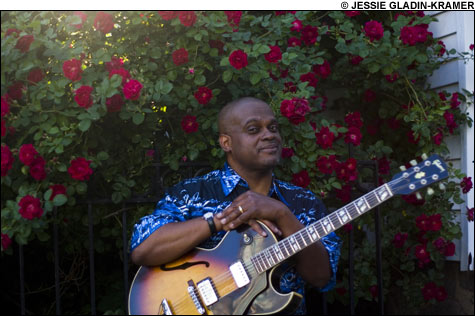
IN THE GARDEN: Fred Woodard keeps on growing. |
WFNX Jazz Brunch Top Five
1. Return to Forever, The Return to Forever Anthology [Concord]
2. Esperanza Spalding, Esperanza [Heads Up]
3. John Ellis, Dance like There's No Tomorrow [Hyena]
4. Laszlo Gardony, Dig Deeper [Sunnyside]
5. Dr. John, City That Care Forgot [429 Records]
|
Fred Woodard graduated from Berklee in 1983 — and that’s when he really started to go to school. Playing in blues bands, reggae bands, R&B, taking “whatever gigs came down the pike,” just trying to make it as a musician, but also always playing jazz.Woodard, whose trio appears at the Lily Pad next Thursday (June 26), had come from Iowa City straight out of high school to study at Berklee — he’d started cello in fourth grade, guitar two years later. But “guitar was more popular — cooler,” he laughs when we get together at Trident Booksellers & Café, on Newbury Street. He had been introduced to jazz through his father’s record collection, and books like Blues People by LeRoi Jones (now Amiri Baraka) and A.B. Spellman’s Four Lives in the Bebop Business (profiles of Herbie Nichols, Ornette Coleman, Cecil Taylor, and Jackie MacLean). “So I was able to find out what the music was.”
After Berklee, as he aspired to follow his jazz-guitar heroes (Charlie Christian, Wes Montgomery, Grant Green, Kenny Burrell, and George Benson), he also had to play gigs that paid. There were some unexpected bumps in the road, however, playing blues and reggae. “I’d come out of Berklee and figured, you know, well, this is easy!”
One of his important post-grad teachers was the late Weepin’ Willie Robinson. “Willie wasn’t a trained musician, and he couldn’t talk in technical terms, but he’d been around a lot of musicians, and he really forced me to examine the blues just through little things.” Those “little things” manifested themselves in Willie’s occasional complaints that something “doesn’t sound quite right.”
Woodard didn’t know what those “little things” were at first. “But I was always taught to respect my elders, so I figured he must know what he’s talking about, because he knew a lot of these guys.” One of the guys Willie knew was B.B. King. Woodard went back to B.B.’s records and started studying. “I figured if I check out B.B., then I should be okay.” He won his way into Willie’s graces, but it was work to keep from backsliding. Once, after he hadn’t been with Willie for a while, Willie commented, “Well, you got some work to do to come back to where you were.” In time, Woodard’s R&B gigs included dates with legends like Sam & Dave and Stax/Volt hero William Bell.
A teaching job in 1994 allowed him to pursue jazz exclusively. His second CD, 1715 (from 2001, on his own Ujam label), reveals a performer who’s mastered both schools — jazz with strong blues feeling. He plays a thumb-picking style in the manner of Montgomery, but with a surprisingly hard edge — on the aggressive, fast take of Green’s “Miss Ann’s Tempo,” you could swear there’s a plectrum biting into the strings. The originals “Now” and “Surfin’ the Changes” allow for movement in and out of the chord progressions, setting up and deferring expectation, refreshing the ear on every chorus.
The interest in shifting tonal centers comes from Ornette Coleman, just as the tensile strength of Woodard’s lines comes from Sonny Rollins’s technique of motivic development. Even the 10-minute trio piece “Surfin’ ” never goes slack.
Woodard is playing the Lily Pad in preparation for a new recording session in August, an album whose title, Urban Garden, refers not only to the gardening he likes to do at his family’s home in Dorchester but also to his teaching work at the Roland Hayes School of Music in Roxbury. He anticipates a few originals, some offbeat covers, and a spiritual or two, in the manner of Green’s Feeling the Spirit (Blue Note). There will probably also be a number that combines hip-hop and swing, in the manner of 1715’s “Stretching/Rebirth of Slick (Cool like Dat).” That piece reunited a Digable Planets track with the James Williams piece it sampled. The title track of the new album “takes an R&B groove and puts jazz changes on it — to show that the two can work together and not come off sounding like smooth jazz.”
Looking back on his post-Berklee studies, Woodard says, “You can learn from playing other styles of music, where you have to be disciplined and give that style of music what it needs.”
“You happy with the Celtics?” asked one of only a handful of listeners as the band set up at the Lily Pad a week ago Wednesday night — the night after the 87-81 Game #3 loss to the Lakers. He was talking to drummer Bob Kaufman, who was wearing a Celtics trucker’s cap and tightening the top bolt on a cymbal. “Who wouldn’t be?” shrugged Kaufman, smiling.